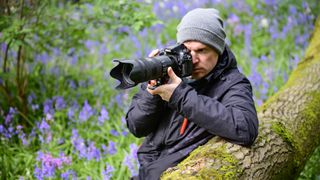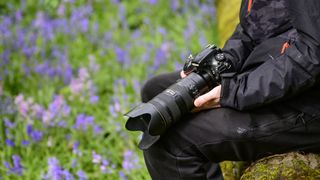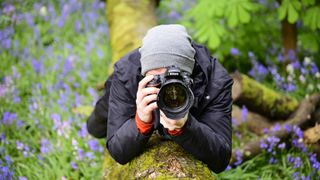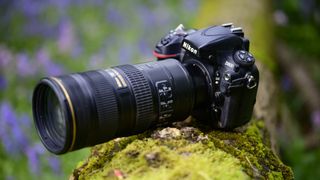I used my DSLR for the first time in years since switching to mirrorless – here's four things I learned
Was it always this much of a struggle?

Take the strain, and three, two, one, pull! No, I'm not in the gym lifting weights, but in the woods with my Nikon DSLR and raising its optical viewfinder to my eye to compose a picture. It's my D800's first outing in years and it's quickly reminding me why I was so happy to switch to mirrorless. At 31.7oz / 900g and combined with my Nikon 70-200mm AF-S f/2.8 VR lens (50.4oz / 1430g) it's well over 80oz / 2300g, and being cumbersome isn't even the worst part.
Don't get me wrong, I'll come away from this walk in my local woods that's bursting with fragrant bluebells and wild garlic with some pictures I'm super-excited about (see below), but boy do I have to work that much harder to get the results I want. And without wanting to lug a tripod around, I actually can't get the same degree of sharpness in my pictures from this day in the dim conditions under a dense tree canopy.
There are aspects of the Nikon D800's handling that I really enjoy and mixing up creative tools keeps me fresh as a photographer, but overall my mirrorless camera is a much more streamlined experience and I'm still glad that I made the leap from a Nikon DSLR to the Z6 II. Let's look at where my DSLR struggles begin.
1. Carrying the gear

My Nikon D800 from 2012 is an extra 50% heavier than the Nikon Z6 II I'm now used to, and also the Z7 II that is arguably my DSLR's modern day equivalent. The 70-200mm f/2.8 F-mount lens is also heavier than the mirrorless Z-mount version, although not by much. Overall, there's approximately a 20% reduction in weight in the mirrorless version of my DSLR camera and lens pairing.
The DSLR camera body is also bulkier, and I notice this quickly with the chunkier handgrip. In some ways it's actually a better balance with the fairly large telephoto lens than what my mirrorless camera offers, but in practice I'm wanting to place the DSLR down quicker than mirrorless.
When you're repeating the motion of bringing the camera's viewfinder up to your eye to compose a shot, the strain starts to take hold quite quickly.
2. Composing the shot

I like the D800's optical viewfinder (OVF), a lot. It's a bright and big display through which I can immerse myself in the scene. And it's one less digital screen to look at, and I'm all for that.
Get the best Black Friday deals direct to your inbox, plus news, reviews, and more.
Sign up to be the first to know about unmissable Black Friday deals on top tech, plus get all your favorite TechRadar content.
However, what you don't get with an OVF, like you do with a mirrorless camera's electronic viewfinder (EVF), is exposure preview, which is supremely helpful as you go about taking photos. You get a bright display but potentially a very different looking final image, both in brightness and depth of field / bokeh.
That can cause a problem for me because I tend to fiddle with exposure compensation based on the mood I want in the picture. It's all too easy to leave the camera at -2EV for a low-key effect and unwittingly carry on shooting dark pictures because the end result is not reflected in the OVF display. Overall, I prefer an optical viewfinder display for the feeling and an electronic viewfinder to meet my practical needs.
Another point regarding my D800 is that its screen is fixed, whereas my mirrorless camera has a tilt display which is super helpful for shooting at low angles, which I often do especially in scenarios like this. Some DSLRs like the Nikon D850 also have a moveable screen, but most don't, and once you're used to working from a tilting or swivel screen, it's hard to go back to a fixed one.
3. Focusing issues

Focusing isn't bad with the D800. It's actually very good, but it's not as refined as the Z6 II mirrorless camera. It's evident as I pinpoint certain bluebells – the focus points simply aren't small enough. I wrestle with autofocus as it hunts for the subject that's right there, more so than with mirrorless.
If I was taking portraits today, I'd be much more relaxed with my mirrorless camera too thanks to its reliable subject and eye detection autofocus, whereas my D800 has regular back-focusing issues.